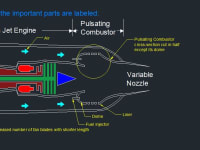In physics, pulsating combustion of gases from two or more different locations near each other will tend to push each away from the other and the resulting velocity of pulsating combusted gases are amplified by the velocity of combusted gases from the other pulsating combustion that are pushing them away. But the case is different in two or more uninterrupted combustions arranged in a linear position (as in the case of jet engines). In jet engines where linear combustion occurs, two or more uninterrupted linear combustions from different locations near each other creates a constant barrier between them, so the amplification of velocity of combusted gases falls shortly in the combusted gases near the barrier only, thus, the resulting amplification of combusted gases through combustion is negligible or of little use.
Now, let’s integrate and apply these principles in turbofan jet and rocket engine, which means that the turbofan jet or rocket engine will operate in uninterrupted and pulsating combustion in a manner that will amplify the velocity of combusted gases from the pulsating combustion, which will also mean that the pulsating combustion will be located between the uninterrupted combustion and the exit nozzle of the turbofan jet or rocket engine. It’s actually just about installing a pulsating combustor before the exit nozzle of the turbofan jet or rocket engine.
Because the fuels are injected directly to the compressed air or oxidizer in the pulsating combustor, this method of thrust augmentation is more efficient compared to afterburner.
The combustor structure for pulsating combustion (pulsating combustor) will be cut in half cross-sectional except its dome so that the other side of pulsating combustor will be left wide open and the highly compressed combusted gases from the turbofan jet engine exhaust or main combustor in rocket engine passing near the pulsating combustor will serve as the wall of the opened area of pulsating combustor so that the expanding combusted gases from the pulsating combustor during combustion will immediately escape through the open wall of pulsating combustor, thus, forcing their way through the passing combusted gases from the turbofan or main combustor of rocket engine, as a result, the passing gases will push the escaping expanding combusted gases from the pulsating combustor through the exit nozzle. As a result, the expanding combusted gases that are escaping from the pulsating combustor will be provided with initial velocity equal to the velocity of passing combusted gases from the turbofan jet engine or from rocket main combustor before exiting the nozzle of the engine.
Advantages:
1. More fuel efficient compared to afterburner because the fuels are injected directly to the compressed air in the pulsating combustor.
2. Low operating temperature compared to afterburner because the oxidizing air are not preheated.
3. Theoretically shorter in length compared to afterburner.
4. Can provide thrust equal to or greater than afterburner, theoretically.
Maybe in concept form but the materials and technology are readily available and the math of physics has spoken so let's build it!
Like this entry?
-
About the Entrant
- Name:Role Alvarez
- Type of entry:individual
- Software used for this entry:AutoCAD
- Patent status:none





